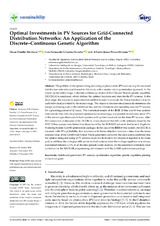Mostrar el registro sencillo del ítem
Optimal Investments in PV Sources for Grid-Connected Distribution Networks: An Application of the Discrete–Continuous Genetic Algorithm
| dc.contributor.author | Montoya, Oscar Danilo | |
| dc.contributor.author | Grisales-Noreña, Luis Fernando | |
| dc.contributor.author | Perea Moreno, Alberto Jesús | |
| dc.date.accessioned | 2021-12-13T12:18:43Z | |
| dc.date.available | 2021-12-13T12:18:43Z | |
| dc.date.issued | 2021 | |
| dc.identifier.uri | http://hdl.handle.net/10396/22207 | |
| dc.description.abstract | The problem of the optimal siting and sizing of photovoltaic (PV) sources in grid connected distribution networks is addressed in this study with a master–slave optimization approach. In the master optimization stage, a discrete–continuous version of the Chu and Beasley genetic algorithm (DCCBGA) is employed, which defines the optimal locations and sizes for the PV sources. In the slave stage, the successive approximation method is used to evaluate the fitness function value for each individual provided by the master stage. The objective function simultaneously minimizes the energy purchasing costs in the substation bus, and the investment and operating costs for PV sources for a planning period of 20 years. The numerical results of the IEEE 33-bus and 69-bus systems demonstrate that with the proposed optimization methodology, it is possible to eliminate about 27% of the annual operation costs in both systems with optimal locations for the three PV sources. After 100 consecutive evaluations of the DCCBGA, it was observed that 44% of the solutions found by the IEEE 33-bus system were better than those found by the BONMIN solver in the General Algebraic Modeling System (GAMS optimization package). In the case of the IEEE 69-bus system, the DCCBGA ensured, with 55% probability, that solutions with better objective function values than the mean solution value of the GAMS were found. Power generation curves for the slack source confirmed that the optimal siting and sizing of PV sources create the duck curve for the power required to the main grid; in addition, the voltage profile curves for both systems show that voltage regulation was always maintained between ±10% in all the time periods under analysis. All the numerical validations were carried out in the MATLAB programming environment with the GAMS optimization package. | es_ES |
| dc.format.mimetype | application/pdf | es_ES |
| dc.language.iso | eng | es_ES |
| dc.publisher | MDPI | es_ES |
| dc.rights | https://creativecommons.org/licenses/by/4.0/ | es_ES |
| dc.source | Sustainability 13(24), 13633 (2021) | es_ES |
| dc.subject | Distributed generation | es_ES |
| dc.subject | PV sources | es_ES |
| dc.subject | Optimization algorithm | es_ES |
| dc.subject | Genetic algorithm | es_ES |
| dc.subject | Planing of electrical grids | es_ES |
| dc.title | Optimal Investments in PV Sources for Grid-Connected Distribution Networks: An Application of the Discrete–Continuous Genetic Algorithm | es_ES |
| dc.type | info:eu-repo/semantics/article | es_ES |
| dc.relation.publisherversion | https://doi.org/10.3390/su132413633 | es_ES |
| dc.rights.accessRights | info:eu-repo/semantics/openAccess | es_ES |

